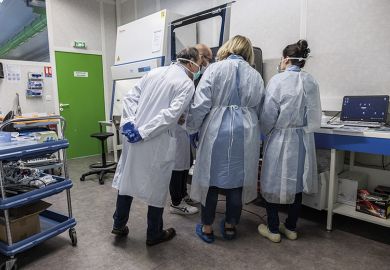Universities have done wonders going online. The sector has achieved in a few weeks what many expected might take years to accomplish, thanks to underappreciated IT teams, creativity by teaching technology specialists and a cast-iron commitment to students by staff.
Another sector undergoing radical digital transformation is retail banking. And while students are not customers and universities are not banks, higher education should perhaps take note.
Banks have shuttered smaller branches, reduced hours and stopped “nice to have in branch services” (passbook updating, balance enquiries etc) in response to Covid-19. There has been a clear shift to online banking. What is left for branches? The hardcore technology hold-outs plus some transactions that have yet to fully shift online, such as paying in cheques. These trends were under way before Covid-19, but neither banks nor people will fully return to the branch-based network that existed pre-crisis.
Instead, eliminating the remaining tasks that need a branch will accelerate. This creates a problem: banks rely on footfall in branches for loyalty and to sell other services that they now depend on to make money.
What does this have to do with universities? Well, courses that are marked by low contact hours and high student-to-staff ratio that have shifted online will not, I think, fully return offline. Is sitting at the back of a 300-seater so much worse than sitting at home or in Starbucks with a subtitled video stream?
Universities then face both the brand problem “how do you sell yourself in a market where everyone else is online” and how do you attract students on to campus? Research-led tutorials and seminars will be the first incantation. But how many tutorials have five or fewer students in a room discussing their course with a research-active academic once a week? How many tutorials comprise six or more students with a harassed PhD student earning money or a “junior fellow” hoping to reach the next rung on the ladder?
As to seminars, once we get more than 15 people, most people say nothing. There are high-quality interactive research-led lectures, tutorials and seminars every day in every university for every degree, but this is far from a universal norm and the trend has been clear. Video conferencing will do a tolerable job for some tutorials and moderated webinars for some seminars. No easy solution presents itself for “exams” but “closed-book, in-person, timed exams” are a diminishing part of assessment.
Some subjects absolutely need students to be in a place, such as those with practical assessment. There will always be a market for top-end research-led education, but I suspect it will need more than assertion to evidence it. Online is massively scalable and will cost much less than £9,000 a year per student to deliver. Moreover, artificially limiting the expansion of online courses from the most prestigious places is unlikely to wash with a government or populace coming to terms with the biggest calamity of their lifetimes.
But a key question remains over what happens if footfall diminishes across the sector. What happens to the add-ons on which universities increasingly relied? Who will pay for the new mixed-use campuses, leisure activity centres, cafes, top-notch accommodation and soft study spaces? These were financed by bonds, loans or complex public-private finance agreements. Like the banks, these add-ons started as a small sideline, but are now a big share of universities’ turnover. We shall see where the risk really lies but, with decreased footfall, these could lose remarkable amounts of money in an impressively short time. A reduction in overseas students will further impoverish the sector intellectually and financially.
Without doubt, the sector needs a government bailout now or chunks of it will collapse. Before contemplating a bailout from the public purse, I am sure vice-chancellors have already cut their own salaries but (if they have) they have been too quiet about it. Such pay cuts, however token, won’t solve the problem but they are likely to be critical for public support so need to be publicised.
I don’t know the right answer to what we do next, but I do know we had all better start some serious thinking. Bailout money will save us but it will come with political control that will transform us. I foresee some form of nationalisation of endowments, as the taxpayer is likely to feel that there are higher priorities in the post Covid world than protecting them.
Unfortunately, the “them, those and us” culture that has grown in universities is ill-suited to this moment. The loudest voices from academia seem likely to be “repent of our sins, return to Eden”. From senior administration, we can expect secrecy. The poor infantry (staff in insecure positions, research staff, clerical staff, service staff) will be done to without so much as a by your leave, as ever.
I don’t relish this turmoil nor would I be thrilled to see universities lose their autonomy to full state control. There was much to love in the old system but it is not coming back any time soon – we all need to come together to change or lose all control of our destiny.
The author is a professor at a research-intensive university in England.
Register to continue
Why register?
- Registration is free and only takes a moment
- Once registered, you can read 3 articles a month
- Sign up for our newsletter
Subscribe
Or subscribe for unlimited access to:
- Unlimited access to news, views, insights & reviews
- Digital editions
- Digital access to THE’s university and college rankings analysis
Already registered or a current subscriber?








